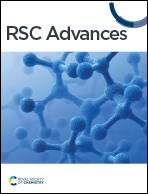Effect of heterojunction structures on photoelectrochemical properties of ZnTe-based photocathodes for water reduction
Abstract
Photoelectrochemical (PEC) properties of ZnTe-based photocathodes with various structures were investigated to clarify the effective structure for the water reduction reaction. Samples with n-ZnO/ZnTe/p-ZnTe and n-ZnS/ZnTe/p-ZnTe heterostructures showed superior PCE properties to the samples without a heterojunction. In particular, the n-ZnS/ZnTe/p-ZnTe sample exhibited a large photocurrent even at a low applied potential in an electrolyte containing Eu3+ ion as an electron scavenger. Appreciable H2 evolution with a constant rate (approximately 87 μmol cm−2 h−1) was also observed over the sample loaded with Pt deposits under visible-light irradiation (>420 nm): faradaic efficiency of almost 100% was obtained, indicating no unfavorable side reaction occurred in the sample.



 Please wait while we load your content...
Please wait while we load your content...